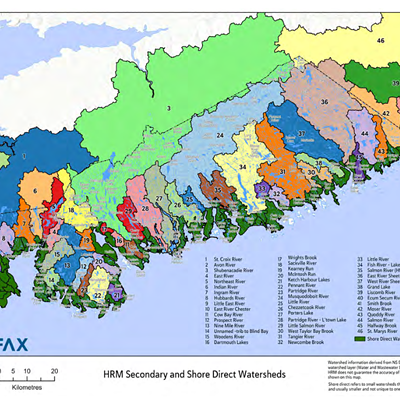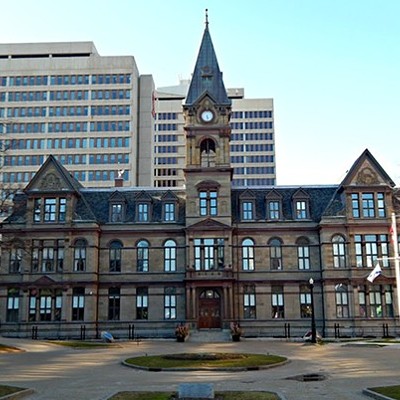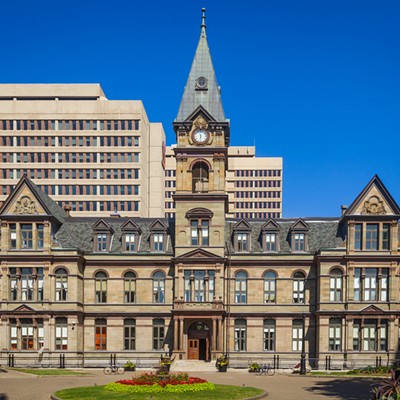It’s no secret that Canadian governmental bureaucracies are mind-numbingly complex. It’s one of the big reasons that politicians are having a lot of success taking political potshots at all three levels of Canadian public service. The Conservative Party of Canada has put out press releases saying that it will build homes by cutting bureaucracy. Provincial premiers like Doug Ford and Tim Houston have cited “cutting red tape” as key policy planks in their tenures; Houston’s provincial government has said that removing municipal barriers to development in Nova Scotia is one of the key reasons for passing the “autocratic” Bill 329 last year.
These formerly wonky arguments brought into the mainstream are getting a lot of purchase by present-day peddlers of populism. And why would they not? We all see our tax bills, which are going up every year. We can see that from health care to the military, governments employ about a quarter of Canadians. And yet, all of the things governments are supposed to fix, from health care to the military, keep getting worse. To anyone who gets exposed to modern variants of the free-market-is-better propaganda campaign, which originally came out of Austria in the late 1800s, it makes sense that if taxes are up, and government agencies are getting bigger as things are getting worse, then some of that spending and/or some of those people has to wasteful. And so it follows that cutting should increase government efficiency and/or reduce spending.
But while this line of thinking makes common sense, it’s worth wondering if it happens to be true.
To get there, we can start by ignoring the ideological pro-free-market economic arguments that say that contracting out the private market is better than having a government do it. The Canadian Centre for Policy Alternatives released a report for this fall’s municipal election which shows that time and again governments save money by bringing services in-house. This, too, is common knowledge, or at least it should be. This is also something anyone who cooks at home intuitively knows because saving money by cooking in-house is the reason you’re not paying a restaurant for dinner in the first place.
Where did red tape's bad rap come from?
Fans of The West Wing may remember a scene where president Jeb Bartlett explains the origin of the term red tape. The fictional Bartlett claims that it’s because Civil War veterans who wanted to receive their pensions had to travel to Washington with their personnel folders, which were bound in red tape. But as Ellen Gutosky writes in the online magazine Mental Floss, the practice of binding folders in red tape started with British kings. The kings would use red to indicate that the file was more important than the boring old white-tape-bound files.
This centuries-old slang for the bureaucratic process has evolved over the years to the point where a former symbol of importance is now synonymous with regulations that needlessly cost time and money. What’s changed over the years is our understanding of red tape. What used to signify a high priority for kings is instead a royal pain in the ass.
One of the sermons the pro-free market crowd likes to make is one of the invisible hand of the market. An omnipotent, omnipresent power that can fix humanity if only the markets were set free. Alas, like most zealots, they’ve strayed too far from their belief’s founding documents. The idea of an invisible hand comes from one of the most influential and one of the first serious capitalism philosophers, Adam Smith. He argued that it was possible to shape society in such a way that people acting in their own self-interest would also be working for the public good. In this way the shape of society would act as an invisible hand to steer us clear of the tragedy of the commons.
This is why a tax on carbon came out of the conservative side of the political spectrum. One of the big issues with the free market invisible hand theory is that something needs to be in a market to be touched by the spectral hand. Even though there are smart people trying to fix this problem, the natural world only fits into markets once it gets commodified. A forest’s value is realized only when the trees are cut down. The conservatives of yesteryear who cared about the environment realized it was easier to regulate those commodities than the natural world. They also determined that if the taxes were primarily levied on companies, the companies using harmful commodities would have to charge more for their product. Since people are self-interested and want to save money, they are naturally drawn to cheaper, environmentally friendly products. An invisible hand, saving the planet.
But things have evolved in the years since Smith’s life in the late 1700s. For example, conservative parties are now leveraging our self-interest to gain power instead of taking meaningful strides to protect the earth (where we live) from the ongoing climate immolation.
But not to despair, because political thinking has also become more refined since the 1700s. Things like zoning bylaws and regulations have been identified as things that can shape society and influence what the invisible hand does. In theory and legislatively, the city has the power to make the city of Halifax a better place using some red tape and the latent power of Smith’s invisible hand. Unfortunately, at the moment in the HRM, our municipal government is using that power to punch itself in the face. And worse, it has used the power of red tape to make it impossible to stop punching itself in the face. The HRM’s rules and regulations are about to inflict upon the HRM the rare self-inflicted knockout.
Should we just move the red tape instead?
Doubly unfortunate for Haligonians, it does not seem like our provincial government has escaped the regression in political thinking that has befallen their conservative counterparts. They do not seem to understand how regulation and red tape can be used to make Halifax a better place. For example, when minister of housing John Lohr explained why the provincial government was passing Bill 329 he said that it was necessary because:
“What we see happening is when HRM Council receives a project that is compliant with the Municipal Planning Strategy (MPS) and is recommended by staff, and then council, for whatever reason votes it down. Six or seven months later the decision goes to the Utilities and Review Board and, in a number of cases, HRM doesn’t call witnesses or provide a defence for their reasons. This is a concern for me. I think HRM has to respect their own process and their own Municipal Planning Strategy.”
It is quite unnerving to hear the minister say this because it demonstrates a fundamental lack of understanding of the issues facing the HRM today. Mainly because those Municipal Planning Strategies are where the city’s power to regulate comes from. What Lohr is describing is a situation like what happened with a gas station on Prospect Road in 2021. The lot was not zoned for a gas station, but the municipal planning strategy on the books supersedes zoning and that document said a gas station was fine. The councillors on the Halifax and West Community Council decided to vote down the gas station anyway. The developer appealed that vote to the Nova Scotia Utilities and Review Board. The UARB told councillors that since their MPS allows this, they too must allow this gas station. An invisible hand, right to the face.
But the important part here is that Lohr is not really demonstrating an understanding of the issue he’s trying to solve. The issue is not that council is voting against compliant projects, it’s that most of the Municipal Planning Strategies are far too lenient in the first place. Council’s intentions and votes are correct; it’s their legislation that’s wrong.
As the province told the city on Jan 16, 2003, car-dependent single-family homes are a fiscal liability to the city. Municipal contractors told the city in 2013 that it costs twice as much to service suburban homes than urban ones. A study from 2017 showed that just accounting for the cost of roads out of property taxes puts the HRM’s budget very deep in the red, although that’s something we learn every year at budget time, too.
Essentially, if the HRM were a corporation (which it is, technically), since its inception in the late 1990s, the main product the city has produced is single-family housing. The municipality has set up a whole framework of legislation, from land use bylaws to Municipal Planning Strategies to allow for single-family housing. This regulatory framework, combined with market incentives for single-family housing, like low interest rates and relatively high profit margins, has led to a proliferation of single-family home development in the HRM. Even though the city loses money on almost every one of our suburban single-family dwelling units, our bureaucracy is set up to try and overcome this shortfall by only increasing the volume of single-family dwelling units.
Unsurprisingly, this has not worked, and as a result, the shortfall in HRM’s budget gets worse every year. Since the city can’t change market incentives, the only power it has to stem this loss is changing what’s allowed by Municipal Planning Strategies and then updating city staff’s evaluations for proposed developments to reflect the changes in the MPS.
Take, for example, last month’s meeting of the Halifax and West Community Council, where they approved 37 more single-dwelling units. Even though this development, when built, will almost immediately be a net loss on municipal resources as described above, staff write that the fiscal implications of this development are that there are no fiscal implications as the developer is responsible for building the development. There is no consideration given to the long-term fiscal implications of this development on the city's books. But even with the very real fiscal implications to the city’s long-term fiscal health, councillors couldn’t stop it anyway because it’s allowed by the MPS.
In recent months, the city got blasted by the Auditor General for failing some critical risk management audits, and in an effort to reassure councillors the CAO told them that risk management was in everything the HRM did. This is true, but this framework, the risk management red tape, is up in the wrong place. One of the criticisms of the HRM’s risk management framework is that it is up to lawyers to determine the risk to the city instead of the accountants. If accountants were in charge of assessing the risk of this development, they might have said that each home is likely to cost a lot more to service than they’ll generate in property tax revenue, which would negatively impact municipal finances “resulting in poor decisions and sub-optimal resource allocation” which increases the city’s exposure to Enterprise Risk number 1 on HRM’s Enterprise Risk Register.
According to the lawyers, the city is not at risk from this single-family dwelling development. Since this development is in line with municipal planning strategies, the city won’t get in trouble with the UARB or sued by developers.
The good news is that the city is starting to mitigate the risks it is exposing itself to regarding land use and the UARB. The changes in the new housing accelerator bylaws are starting to address this foundational unsustainability in the centre plan area. The city is currently working on updating the suburban and rural plans, and when they do, it is vital that municipal planning strategies empower the city with appropriate use of red tape to ward municipal processes away from the danger of fiscally insolvent development patterns. The city needs to change municipal planning strategies to empower itself to deny fiscally draining development in front of the UARB.
Once the regulations are in place to influence the invisible hand, if it still isn’t working only then should we consider cutting some red tape.
gd2md-html: xyzzy Wed Aug 14 2024
gd2md-html: xyzzy Wed Aug 14 2024
















